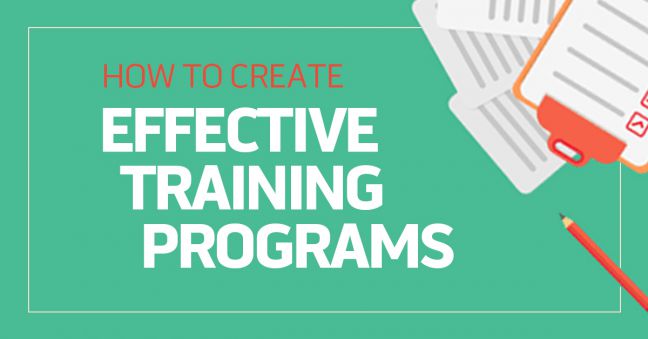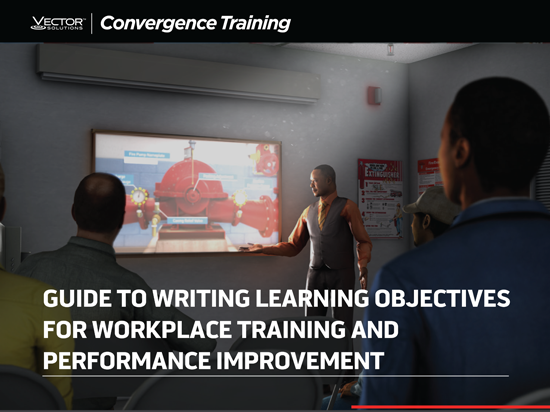
Nearly everyone recognizes the value and benefits of workforce training. When done properly, training can make workers more efficient — increasing production, revenue, and profits while decreasing costs, waste, and inefficiencies. Effective training can lead to increased compliance with regulations. It can even lead to a happier, more satisfied and engaged workforce, which in turn reduces turnover and costly new employee onboarding. So the benefits are many.
But creating effective training isn’t easy. Some common problems include creating training that doesn’t support a true business goal, or that’s intended to solve a problem that training can’t fix, or without first identifying the true purpose of the training, or that includes too much information. Or maybe all of those things.
So, how does one create effective workforce training materials? Below is an eight-step road map to help you create more effective training materials. Entire books have been written about each of these steps, so there’s far more to say than what’s written below. But this article should serve as an effective getting-started guide in your quest to create workforce training materials that actually work.
Beyond that, we’ve added some notes in the conclusion of this blog to get you thinking in a “what’s next?” manner. Because the neat thing about designing, developing, delivering, and evaluating training is that you’ll never know everything and you’ll be best-served by being a lifelong learner yourself.
- Learning Management Systems
- Online Workforce Training Courses
- Workplace Scheduling Tools
- Safety Management Software
- Mobile Training Apps
Step 1: Perform a Training Needs Assessment

Imagine someone at work perceives a problem and thinks a new training program might resolve it. For example, maybe the production manager says that her workers need to be more efficient and create more units of a product. Before anyone rushes off, creates training materials, and conducts the training, it’s a good idea to take a step back and assess the situation.
The first thing you should do is to analyze the performance problem to get a better idea of what’s causing it and to see if training is really the best solution. We’ve explained this in our Analyzing Performance Problems article. Read that article and come right back here when you’re done 🙂
If you’ve analyzed the workplace performance problem and determined that training really is the right solution, then it’s time to start your research for the training. That’s what the training needs assessment is for.
The basic training needs assessment is a four-step process. Those steps are:
- Identify a clear business goal that the training supports
- Determine the tasks the workers need to perform so the company can reach that goal
- Determine the training activities that will help the workers learn to perform the tasks
- Determine the learning characteristics of the workers that will make the training more effective
Sounds simple enough, but let’s break those four steps down a bit more.
Identify the business goal:
Don’t provide training if it’s not clear why you’re doing it, or if it doesn’t directly support a business goal. Business goals include things like increasing revenue and efficiency, decreasing costs and waste, supporting a new product, teaching a new or changed production process, or complying with regulations. For example, a business goal might be to train employees to create a new product.
Determine the tasks workers need to perform:
Once you’ve identified the business goal, ask yourself what your employees have to do if the company is to reach that goal. During this phase, you’ll identify the “performance gap” between what your workers can do now, and what they must be able to do. To keep with our new product example, the workers might need to know what the new product is, how the product is produced, and (most importantly) the tasks the workers must perform on the job to make the product.
Read this article to learn more about how to conduct a job task analysis.
Determine the training activities that will help workers learn to perform the tasks:
You’ve identified what the workers need to do, so now you have to identify the training activities that will help them learn to do those tasks. To continue our example, this may include a quick and short explanation of the product, an equally quick and short overview of the production process, and demonstrations mixed with hands-on practice of the tasks they’ll have to perform on the job.
You might find this article on Different Types of Training for Different Types of Learning helpful here.
Determine characteristics of workers that will make the training more effective:
Finally, consider the characteristics of your workers to determine the type of training that will be most effective for them. In a perfect world, you’d cater training to each individual, but that’s not always possible and you may have to consider the average characteristics of the group as a whole. Consider these kind of things: are they more comfortable with computer-based training or instructor-led training; do they like self-guided or self-paced learning, or would they struggle in that environment; are they youngish or older; are there cultural issues that may factor in; do they learn better from reading, listening, or doing; etc. And because it’s hard to create one-size training that fits all, consider training that blends different aspects so you’ve got a better chance of reaching everyone.
You might want to read this article for more about Business Goals, KPIs, and Job Training.
Step 2: Keep Adult Learning Principles in Mind

You could argue this step is already addressed at the end of step 1 or will factor into later steps, and you’d be right. But it’s important enough to call it out on its own.
The workers you want to train are adults, and adults share certain characteristics that that make training more effective for them (or less effective if you ignore the characteristics). If your training recognizes and respects these adult learning principles, it’s likely to be more effective. If your training disregards these principles, you’re throwing training money out the door from the word “go.”
So what are these principles? Adult learners:
- Are self-directed
- Come to training with a lifetime of existing knowledge, experience, and opinions
- Are goal-oriented
- Want training that is relevant
- Want training that is task-oriented
- Learn when they see “what’s in it for them”
- Want to be and feel respected
You can see how these principles relate to the learner characteristics you identified during your training needs assessment. And you can imagine how they should affect your training during design and delivery. Remember the old saying that “you can tune a piano but you can’t tune a fish?” Well, if you ignore adult learning principles, you’ll be trying to tune fish all day long.
If you want to dig a little deeper into this, check out our articles on evidence-based training methods and learning myths.
Step 3: Develop Learning Objectives

Before you begin creating any training, it’s critical that you create a list of learning objectives.
Learning objectives are a list of things the workers must be able to do after the training is completed. They are the “North Star” that all aspects of your training should be pointed at. Once you’ve created your learning objectives, create content that covers the objectives—and nothing but. In addition, any quizzes, tests, case studies, or hands-on exercises performed during training to evaluate your worker’s comprehension of the training should assess only the workers’ understanding of the objectives. And finally, any observation of workers when they’re back on the job to evaluate the effectiveness of the training should also focus on the performance of these objectives.
To (intentionally) overstate the point, learning objectives are the end-all and be-all of your training. Without objectives, you’ve got an out-of-control car without a driver.
There’s a lot to be said about learning objectives (and even more to be said); we’ve included a few tips below.
They Can Address Knowledge, Skills, or Attitudes (KSAs):
A learning objective may address things that your learners can “know,” such as how product flows through a machine; skills that your learner’s can perform, such as threading materials into a machine; and attitudes that your employees can hold, such as the importance of threading materials into a machine properly in order to create the best possible product.
Make them SMART:
When you write an objective, it should have five characteristics, known collectively by the acronym SMART. The objective should be specific, meaning it’s very clearly stated and its meaning is equally apparent to everyone. It should be measurable, meaning everyone can agree if the learner satisfies it or not. It should be achievable, meaning the learner truly has a chance to satisfy it. It should be relevant, meaning it’s important for the worker’s job. And it should be time-bound, meaning it will be clear when the learner must be able to satisfy the objective (typically, after training).
You can read more about Writing SMART Learning Objectives here.
Give them four parts (ABCD):
A learning objective should include four parts, which you can remember with the letters ABCD. It should include an actor who will perform the objective (the employees you’re training). It should include a behavior that the actor must perform (this behavior should be stated as a verb that defines the workers’ behavior, such as “recite” or “turn”). It should include conditions under which the employees must perform the behavior (for example, “given a wrench, the employee must…”). And it should include the degree to which the employee must perform the behavior (for example, “90 times an hour”).
You can read more about four-part, ABCD learning objectives here.
Download our free, extensive guide to creating learning objectives.
Step 4: Design Training Materials

Designing training materials is like planning a dinner party, coming up with a menu, and writing the recipes. It’s the “plan before you do” phase of training creation.
While you’re designing your materials, keep the following points in mind:
- Remember that it’s important to design before you rush into the next step (development)
- Always focus primarily on the learning needs of your employees, and not on what’s easy for your trainers
- Only create training content and assessments that relate directly to your learning objectives
- Remember the adult learning principles
- Include as much hands-on practice or simulation as possible: people learn by doing
- Whenever possible, put the employees in control of the learning process (instead of the trainer)
- Do everything possible to let the employees talk and interact with the trainer and with each other during the training
- Make sure there’s plenty of opportunity for feedback during training
- Break your training materials up into small “chunks” that are easier to take in and understand
- Order your “chunked” training materials in a logical manner—one step that builds on top of another, or chronologically, etc.
- Try to use a “blended learning” approach that includes training in several different formats (computer-based, instructor-led, etc.).
- Try to integrate storytelling and scenarios into your training
- Try to appeal to a variety of your workers’ senses during training—sight, hearing, touch, smell, and taste (when appropriate and not dangerous). Sight is by far the most important sense for learning, but adding the others when possible does help.
The book Design for How People Learn, by Julie Dirksen, is a great resource for more information about this step.
We’ve also pulled together the following links related to designing effective training materials for you:
- Steps of Creating Training Based on Cognitive Psychology
- Different Types of Training for Different Types of Information
- Matching Types of Information and Graphics in Training
- Blended Learning Guide
- Blended Learning by Feedback Need
- Chunking Your Training Materials
Step 5: Develop Your Training Materials

Once you’ve got your training materials designed, now’s the time to roll up your sleeves and start developing them. It’s like you’ve written a recipe and are ready to cook the meal.
You may create a variety of training materials using several different tools during this step. Here’s a look at a few options:
- Word, Excel, and similar “Office” programs to create handouts for employees and to create training outlines and notes for the instructor of any instructor-led components
- Materials for hands-on elements and/or role-playing elements of the training
- PowerPoint for in-class projections and/or handouts to deliver to employees. Beware of PowerPoint presentations that are nothing but screen after screen of bullet points, however.
- Flip-charts, posters, transparencies, and/or computer-generated graphics for presenting visual materials during training
- E-learning authoring tools such as Articulate Studio and Storyline or Adobe Captivate for creating computer-based e-learning modules
These are just a few ideas, and technology is bringing new possibilities every day, including virtual reality and augmented reality. Be creative and mix and match these to best fit the employees’ training needs. While creating materials, always keep in mind two primary concerns: (1) the things that will help your employees learn most effectively and (2) the learning objectives.
This blog, by Connie Malamed, has lots of great tips on developing training materials.
We’ve also pulled together these articles related to training material development:
- Writing Instructional Materials
- Format Your Written Training Materials for More Effective Learning
- 25 Graphic Design Tips for Training Materials
- How to Make Your Own e-Learning Course (article)
- How to Make Your Own e-Learning Course (webinar)
You may also want to consider partnering with a training provider for off-the-shelf or custom training materials.
Step 6: Implement the Training

If designing is like writing a recipe, and developing is like cooking the meal, then this phase is setting the table, ringing the dinner bell, and eating the food.
It may seem obvious, but one of the most critical things you’ll have to do in this phase is inform the employees that will attend the training. Give them plenty of time in advance so that they can work it into their schedules and complete any necessary pre-training preparation.
One thing to keep in mind is that a learning management system (LMS) can play a big role in helping you during this step. An LMS is a software application used assign, deliver, track, and report on training. If you use an LMS at work, it’s easy for your employees to log in and see the list of training they’ve been assigned. Many learning management systems even include notification systems that send emails to the workers when new assignments are made or due dates are approaching. In short, an LMS can automate a lot of the clerical, scheduling, and notification procedures you’d have to do yourself in this step (and they do a lot more than that, too).
In addition, you may also have to do things like inform the workers’ supervisor, reserve rooms for training, buy any necessary supplies, work through any scheduling or traveling logistics, and perhaps even have food and drinks available. Get your ducks in order in advance, so your training goes off as smoothly as possible.
Moving forward to the actual training, the implementation can take a variety of forms. It may be classroom instruction; practice opportunities such as role-playing exercises, focus groups, case studies, or small group assignments; on-the-job skills-based training; the delivery of paper-based hand-outs for individual reading and study; the completion of e-learning modules on a computer; a combination of some or all of these; or more.
If your training includes an on-the-job skills-based component, make sure you know exactly what the employees must do to demonstrate competence. Define this in advance, when you’re creating your learning objectives, and don’t leave it unstated or vague.
If your training includes a classroom instruction component, there are a number of things you can do to make this more productive. Although the key things involve letting the employees be active participants instead of passive and bored listeners, more mundane things like room temperature, lighting, table and chair set-up, visual aids, and the instructor’s presentation style also play a role. There are a number of good books and websites that can you help you with this; the Association for Talent Development (ATD) website is a good place to start looking.
Here are some additional articles related to training delivery and management:
Download our free LMS Buyer’s Guide Checklist.
Here’s a quick two-minute overview of a learning management system (LMS).
Step 7: Evaluate the Training

It’s easy to provide training to workers, pat yourself on the back, and think you’re done. But if you do, you’ve put your cart before your horse.
If your goal is to deliver effective training that changes your worker’s behavior on the job—and this SHOULD be your goal—then you need to confirm that the training was effective. The standard way to do this is to use Kirkpatrick’s Four Levels of Evaluation.
As you may have guessed, this method involves evaluating the effectiveness of your training at four different levels. Those four evaluations are:
Employees’ reaction to training:
Did the employees like the training? Did they feel like they learned? You can find this out by observing the employees during training, asking their opinions, or handing out surveys. You can hand out paper-based surveys after training if you want, but you may get better results if the survey is online and anonymous. Survey Monkey provides free online tools to help you do this.
Employees’ actual learning:
Assessments during the training should evaluate the employees’ actual learning of the objectives. This might include simple tests for knowledge issues, or case studies, job simulations, or hands-on exercises for skills and attitudes.
- Testing Employees After Training
- How to Write Better Multiple-Choice Questions
- How to Write True/False, Matching, and “Other” Types of Questions
- Testing and Fidelity
- Testing, Reliability, and Validity
Employee’s post-training job behavior:
Are the workers taking the new knowledge/skills/attitudes from training and applying them at work where it counts? Observations of the employees’ on-the-job work behavior will determine this, as will other performance-based metrics.
Quantifiable business results:
Did the training result in reaching the desired business goal (i.e., did revenues rise, did costs decrease, was the new product manufactured properly, or were workplace incidents reduced)?
After you’ve performed these four levels of evaluation, you may determine that the training was as effective as you hoped, or even more. If so, congratulations and job well done. Now you can pat yourself on the back. On the other hand, these evaluations may show that your training wasn’t all you hoped it would be. If so, it’s time to revise the training and get things up to snuff.
- Level 4 Training Evaluations
- Business Goals, KPIs, and Job Training
- How to Measure the Impact of Training on Business Goals
- Big Data and Big Learning Data
Readers with long memories may have read about Kirkpatrick’s Four Levels of Evaluation and felt the familiar tingle of déjà vu. If so, that’s because Kirkpatrick’s four levels map directly to the four steps of the training needs analysis described at the beginning of this article. Check it out for yourself in the table below.
| KIRKPATRICK’S FOUR LEVELS OF EVALUATION | STEPS OF TRAINING NEEDS ASSESSMENT |
|---|---|
| Employees’ reaction | Did the employees like the training? |
| Employees’ learning | Did the employees learn from the training? |
| Employees’ post-training job behavior | Are employees performing desired tasks on the job? |
| Quantifiable business results | Was the business goal reached? |
Readers “in the know” may also know that the classic Kirkpatrick Training Evaluation model has been updated a bit lately. Click to read about the updated New World Kirkpatrick Model from the Kirkpatricks themselves.
If you want to take a deeper dive into issues related to learning and/or training evaluation, check out these two resources:
Step 8: Rinse, Lather, and Repeat Any Step When Necessary

You may have to return to different parts of this 8-step process in the future for a number of reasons. As mentioned above, one would be if your original training proved to be ineffective at any of the four levels. But you may have to do it again if you get new employees or if the work process changes.
But that’s no cause for panic. Now that you know the method, just work your way through. If you made some errors the first time—maybe you misjudged your employee’s learning needs, misidentified the learning objectives, provided too much information during training, put too little information into job aids, or held an instructor-led training that was dominated by the instructor—just go back and do it better the next time.
In addition, don’t forget that one-and-done training sessions often don’t work well (it’s because of how we learn). You should probably consider adding a spaced-practice element to your training programs. For more on this, read the following articles:
- Evidence-Based Training and Spaced Learning
- How to Use Spaced Practice to Support Memory in Job Practice
- How to Beat the Training Forgetting Curve
Conclusion: Effective Training Programs Are Within Reach at Work
So there you have it. Does training have an important role at the workplace? Absolutely. But it can’t solve every problem, and its effectiveness depends on how it’s designed, developed, and implemented. If you follow the eight steps listed above, you’ll find that your training programs will be much more effective, leading to an increased training ROI, happier employees, and the attainment of key business goals.
At the beginning of this article, we mentioned that there’s a LOT more to be said on this topic. For example, while this article presents the steps of training development progressing in a linear, “waterfall” method, training developers today often depart from this for various reasons (for example, see the book Leaving ADDIE for SAM by Michael Allen).
Another interesting way to approach this issue is captured in a model created by Dr. Will Thalheimer that I very much like. He calls it his “training maximizers”–check that out at the Training Maximizers article on the Will at Work blog.
You’ll also find that sometimes training isn’t the best solution. Instead, there are lots of cases when you would be better off preparing performance support/job aids for workers.
In addition, you’ll also notice that formal training like the stuff we talked about in this article is best considered as part of a “blended learning solution” that also includes and facilitates experiential learning and social learning. Read about that here in our introduction to 70/20/10.
Finally, you may want to check out the following training guides to see a lot of these workplace training best practices in more specific applications:
Anything else we should have added? We haven’t mentioned microlearning, or scenario-based learning, or social learning, or spaced practice, or a variety of other things yet. Please leave a comment below!
And feel free to check out our libraries of online workforce training courses. They’re all ready to go in handy SCORM and AICC formats for immediate importing into a learning management system (LMS).

How to Write Learning Objectives
Get this free guide to learn all you need to know to write learning objectives, create better training, and help improve workplace performance.

A great article for anyone starting out in the ID field. A must read.
Glad you liked it, Kendra. Thanks for the nice words. Have a great day.
Hello Mr. Jeffery Dalto. I’m from Cambodia. I would like to thank very much for your thorough ideas on the effective training program. It is easy to understand and very helpful to my job.
Sann, I’m very happy to hear that you found this helpful. Best of luck to you!
Hello Jeffrey, it really nice articles and good lesson for me to join Training Manager position in a few weeks. You start from the assessment and end up with evaluation, it very clear to start the great training program.
Great piece of writing and tips for someone like me doing research on training effectiveness in the South African Public ervice
Thanks, Solly, for the kind words. We’re glad you found this helpful and hope you’ve found some of the other articles helpful as well. Let us know if there are other topics you’re researching. Otherwise, have a great day.
Hello Jeffrey, I am a public health expert and now I need to develop a training module for my organization. This article gave me a nice introduction to the area but I need some good literature. Can you please help me with that?
I’m at the beginning stages of creating a training program for my dispatch center on stress management. This information is just what I was looking for!
Dave, that’s great, and it’s also great to hear. Thanks for letting us know, it helps us know what kind of content to provide.
Also, keep your eyes on the blog, because we’re currently working on creating an expanded version of this article in a downloadable guide (more than 30 pages).
Thanks again and good luck to you.
Jeffrey – can you send me an email when the downloadable guide is ready. We employ interns during the summer, and I give them projects that include meaningful safety training that incorporates some of the principals noted above. I’d like to give them the downloadable guide (and make use of it myself).
Thank you,
Steve Markowitz, Director of Risk Control, Sterlingrisk
Steve, I’ll try to remember to.
That said, I’m human and might forget. What I suggest is that you sign up for our newsletter. Are you signed up already? If so, you’ll get the guide automatically–our newsletter serves as a “greatest hits of the blog” each month.
This link should work: http://convergencetraining.us2.list-manage.com/subscribe/post?u=a4b05dfd189f9574a4a2889f8&id=c916913921
The guide is coming soon, by the way…
I totally loved all the information based on training. Especially the part based on chunking it made me realise that it is very importation to break down information in order for people to absorb it easier. And that it is always important to start with the easier part information that people have knowledge to in order to create that intrest. Then later go to the most difficult part
Glad you found it helfpul!
Thank you for doing this job since i have found it helpful in my resuch work in KISII UNIVERSITY IN KENYA AND MOST IMPORTANT IT HAS LEFT ME A BETTER MANAGER OF A JOB IN AN INSTITUTION ONCE AM DONE WITH MY STUDIES.thanks once again.
Thanks for the nice words, Elvis. Much appreciated. Glad the article helped, if only a little bit.
Thanks for the article, It really useful, I am creating a content on employee effectiveness and team building at workplace, Would you support me in that or can provide any information regarding the same.
Thanks!!
Lokesh Gupta
Nice article. I think the first step i.e need analysis is the most important to create high efficiency training courses .
Chandan, there’s no doubt that the TNA is important, you’re absolutely right.
Just started to do trainings with our lower level management people. This is a very helpful guide.
Grace, glad to hear that worked well for you. Good luck with your trainings.
Excellent guide. Thank you for posting it.
Glad you liked it, Ruxandra. Have a nice day.
Thanks Jeffrey Dalto for such a wonderful article regarding HR function of Training and Development. It would help me to design a perfect Training program in my career.
Zaid, glad you found it helpful. Come back again.
Cheers and best wishes!
I came across your blog when preparing for an interview for a training coordinator role in food manufacturing. It was exactly what I was looking for, a structured approach to training. I will definitely refer to your page in the future! My goal is to create a training program that will make people excited to learn and boost confidence. Thanks for this clear and comprehensive post.
Kim, that’s great. I hope your interview goes/went well and that you get the job and that you reach your goal (and then more).
Best wishes,
Jeff and Convergence
Thanks for sharing Jeffrey , to implement it.
Regards,
Ray Palmeros
Ray, glad you found something helpful there. Best of luck to you.
Where in Mexico do you work for Nissan? I used to live in Jalisco, a little north of Manzanillo.
Thank you Jeff,
I’m working in Aguascalientes, it is near where you lived.
Currently as risk prevention.
SAFETY FIRST, SAFETY LAST, SAFETY ALWAYS.
Regards,
Ray Palmeros
Oh yeah, I’ve never been there but I know where it is.
I ALSO once lived in Sayulita, north of Puerto Vallarta, even a little closer to where you are now.
Well, nice to meet you. Have a good one.
Jeff understand, the world is very small!
Have a good day.
Regards,
A near-complete Training Guideline for the Trainers which is sure to benefit any Trainer, be it a Budding, Practicing or even a Senior One. The principles described have been presented in an easily understandable, lucid style which makes it an interesting and refreshing reading. Thanks for your concern for developing the Training Fraternity. Please continue your services with still further relevant and newer materials. Thanks again.
Thanks, Ameer.
As for creating more/newer stuff, you may be interested in our just-published article on scenario-based learning, and a recent one on big learning data.
Scenario-based: https://www.convergencetraining.com/blog/using-scenario-based-learning-for-manufacturing-training
Big Learning Data: https://www.convergencetraining.com/blog/big-data-and-big-learning-data-in-manufacturing
Past, Present, Future of Manufacturing Training: https://www.convergencetraining.com/blog/manufacturing_training_past_present_future
Very interesting, I am recent into training and this has been a useful link. Does anyone know of any companies that can produce the training content, I am find I have very little time as quite busy , so this would help me move things for my clients.
Alex, we offer “off-the-shelf” training (http://www.convergencetraining.com/elearning-courses.aspx) as well as custom training (http://www.convergencetraining.com/custom-process-training.aspx).
You can contact us here: http://www.convergencetraining.com/contact.aspx
I have just looked at your link to your site, I think it is very impressive. I would be interested in representing the product however your field is limited to certain areas. For example there is no programs on sales, as my market is in great need for soft skill training I see this as having greater potential. Another point is, in respect to the audio, local language is better and so can we dub over the audio. Perhaps a skype call would help. Please advise.
My skype is alexgehales
Thanks
Beautiful piece, it was so helpful to me as I have been conducting trainings but leaving somehere important bits and pieces that you have highlighted here. Your piece can see a trainer through a training program successfully. Thanks.
Dauda, glad you found some helpful stuff there. Have a great day.
A good piece of work which is of paramount importance to people like me who wants to prepare a training programme. Thank you very much Jeffrey you did a wonderful job.
Mlevu, glad you found something helpful. Cheers to you.
Great article, I got a lot from it. i have a better insight on putting together my training package for my company.
Hi, Dorothy, glad you found this helpful. Have a great day.
Great information , i leaned a lot from it. Good luck.
Abdel, thanks for the kind words. Glad you found some stuff of value there. Hope you find more if you poke around through other similar articles. Have a great day.
Awesome insights!
Mini, glad you found something useful there. Have a great day.
Thank you for a productive information.
You’re welcome, Gigi. Glad you found some stuff of value there.
I liked the design very insightful; I would have added a brief writing assessment for the learners to measure their level of comprehension! to make sure they have a superficial understanding.
Thanks, Julius. Have a great day. 🙂
Thanks a lot for the great article with insightful information! Looking forward to learn more…
Kaumudi,
Glad you found something helpful there.
Best wishes to you, and have a nice day.
Nice summary of key points in the process.
Thanks, Chris.
That’s our “basic overview,” as you note.
Have a great day.
Great article, very well explained and easy to understand, helped me a lot with my homework.
THANK YOU!
Glad it helped, Angelica. Have a great day.
What do you study/where/what grade level?
Great article
it has helped me as a project officer
Glad you found something helpful there, Faith. Have a great day and come back as often as you wish. Cheers to you.
Fantastic !!!
Glad you found something helpful there, Sunil.
Have a great day.
Stumbled upon this great article when i needed this most. Thanks Jeff
You’re welcome. Glad it helped.
Have a great day.
Good Job Dalto,
Highly considered topic even for trainers that have spent decades in the field, one more thing could be added to those beneficial steps which is ” After Course Communication” term ; I used to collect my trainees in an optional group like any social group to share any news, regulations & legislation updates and to help as a team in addressing some of job related problems that may seem to be new for somebody and not for others. Through my experience in this strategy I obtained:
1. Long term effective team work form.
2. A network of professionals each can contact with all or some of the team members all the times.
3. Deep trust in the trainer vision of following up & delivering his knowledge to his trainees out of the course period.
4. Most of the times this technique resulted in a good social relationships, the guys arrange for home visits, going shopping and sharing sports..etc.
Again thanks Jeff for this topic hope you the best always.
Basil Abu Asi
QHSE Specialist
Jordan
Good additions, Basil, thanks.
This has been so helpful JEFFREY DALTO.. was given an assighnment in desighning a training programe for teachers, i didnt even know where to start from but after reading this article, my mind is open and ready to do it. Thank you!
Joy, glad you found this helpful. Good luck with that assignment.
I am developing a safety training module for employees working in mining sector.
Excellent article, must compliment you. The note on adult learning is very apt, for experienced workers
Amitava, thanks for the nice words and we’re glad if you found something helpful there.
Let us know if we can help you in any way with the mining safety training.
Thanks Jeffrey for this article. It’s a must read for any Training professional tasked with building a program from scratch. I’m relatively new to the Training Department, but have spent 20 plus years in the Paper Industry in Technical/Operations roles. Many mills and companies are preparing for a wave of retirements and having a robust training program is paramount.
Glad you found that helpful, Chris.
I shot you off a quick email (to your work account).
Good luck with the new training job. Let us know if we can help in any other way.
Very nice information
Glad you found something helpful there, Rahil. Have a great day.
very comprehensive article , cover main points for anyone wants to create a training program, thanks a lot
glad you found that helpful, Zakariya.
Thank you a lot for sharing the awesome post. Very easy to memorize, one can apply the tips very conveniently, while creating a training program.
Glad you found something helpful there! Best wishes to you. 🙂
very helpful,thank you very much for this information.
My pleasure, Philice.
Great information. I am preparing for a training to staff on M&E but did not how to create an interesting one. Now I can plan better with an assessment first this week then training after atwo weeks from now. thanks a lot.
Glad you found something helpful there, Siama.
please support me, plan a short training curriculum for creating site maintenance committees and training these committees in upgrading activities.
Abdirizak,
Thanks for writing.
If you follow the tips in the article above, you’ll do well.
You may also want to include some of our online courses for industrial maintenance in the curriculum. We have those listed here: https://www.convergencetraining.com/industrial-skills-training.aspx
Finally, touch base with us if you’d like to investigate having us create custom training for your team: https://www.convergencetraining.com/custom-process-training.aspx
Very effective content indeed.
Glad you found something helpful there, Rahul. Have a great day!
A superb article. Well done. I wish I had this when I first started out with the ID. I’ll certainly be pointing my students to this site.
Glad you found something useful, Clara. Best of luck to you and your students.
I needed this , thank you very much for all the information 🙂
Glad you found it helpful!
thank you 🙂
I found this a very helpful article which i am about to start another kind of work . This is related to my next job assignment .
Thank you so much. God bless.
Glad you found it helpful, Alyna! Good luck with your new position.
Excellent article …great informations
Thank you very much
God bless you
Glad you found that helpful! Have a great day.
Thanks Jeffrey Dalto It is very helpful. Excellent article …great information.
Thanks to you as well. Hope it was helpful. Have a great day.
I have been scouring the internet for the best way to design an L&D proposal for a company project I have in mind. These 8 steps are not new to me, but I have never had them organised in a format I could go to. Usually I am in a stand alone role, and much of the process comes naturally, however I find myself in a position where a formalised process and project management is required. This article has saved me hours of work! Thank you!
Lori, so nice to hear this may have been of some help. Best of luck to you with your proposal.
very useful article learned many information on Training.
Glad you found something useful there, Arun. Have a great day.
Hello,
Great piece of knowledge. This has been very helpful. This is indeed A MUST READ
Glad you found something helpful there, Danny. Have a great day and let us know if you have any questions later.
This article worth a thousand books. Thanks Sir for your valued input here….
Thanks, Pissu. Glad you found something helpful. Have a great day.
very interesting article i enjoy reading it
Thaks, Mohammed, hope you found something you can use there.
Great article.Thank you Jeffrey.
Glad you found something useful there, Onesmus. Have a great day and keep in touch.
Hi Very interesting – Do you have a specific program for sales force
Normand, we don’t offer SalesForce training (sorry). I hear they have a great resource called Trailblazer though (or maybe Pathfinder?). Have you heard of that?
Thank you Sir for an amazing article! I am in a transitional phase of life and this help to glue a major piece of the puzzle together for me…
Glad that was helpful, Christopher! Best wishes in the “transition!”
An extremely helpful article. love the steps and details.Great work and thanks.
Glad you found something helpful there, Nami! Thanks for the comment and best wishes to you.
Hello JEFFREY DALTO, I’m from Pakistan. I would like to thank very much for your ideas on the effective training program.its seems to good article for beginner ,it is very helpful and informative
writing material.
Muhmal, glad you found some value there. Best of luck to you and keep in touch. Cheers!